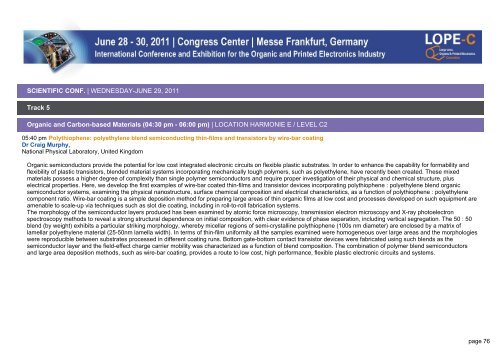Conference Program - LOPE-C 2011
Conference Program - LOPE-C 2011
Conference Program - LOPE-C 2011
Create successful ePaper yourself
Turn your PDF publications into a flip-book with our unique Google optimized e-Paper software.
SCIENTIFIC CONF. | WEDNESDAY-JUNE 29, <strong>2011</strong><br />
Track 5<br />
Organic and Carbon-based Materials (04:30 pm - 06:00 pm) | LOCATION HARMONIE E / LEVEL C2<br />
05:40 pm Polythiophene: polyethylene blend semiconducting thin-films and transistors by wire-bar coating<br />
Dr Craig Murphy,<br />
National Physical Laboratory, United Kingdom<br />
Organic semiconductors provide the potential for low cost integrated electronic circuits on flexible plastic substrates. In order to enhance the capability for formability and<br />
flexibility of plastic transistors, blended material systems incorporating mechanically tough polymers, such as polyethylene, have recently been created. These mixed<br />
materials possess a higher degree of complexity than single polymer semiconductors and require proper investigation of their physical and chemical structure, plus<br />
electrical properties. Here, we develop the first examples of wire-bar coated thin-films and transistor devices incorporating polythiophene : polyethylene blend organic<br />
semiconductor systems, examining the physical nanostructure, surface chemical composition and electrical characteristics, as a function of polythiophene : polyethylene<br />
component ratio. Wire-bar coating is a simple deposition method for preparing large areas of thin organic films at low cost and processes developed on such equipment are<br />
amenable to scale-up via techniques such as slot die coating, including in roll-to-roll fabrication systems.<br />
The morphology of the semiconductor layers produced has been examined by atomic force microscopy, transmission electron microscopy and X-ray photoelectron<br />
spectroscopy methods to reveal a strong structural dependence on initial composition, with clear evidence of phase separation, including vertical segregation. The 50 : 50<br />
blend (by weight) exhibits a particular striking morphology, whereby micellar regions of semi-crystalline polythiophene (100s nm diameter) are enclosed by a matrix of<br />
lamellar polyethylene material (25-50nm lamella width). In terms of thin-film uniformity all the samples examined were homogeneous over large areas and the morphologies<br />
were reproducible between substrates processed in different coating runs. Bottom gate-bottom contact transistor devices were fabricated using such blends as the<br />
semiconductor layer and the field-effect charge carrier mobility was characterized as a function of blend composition. The combination of polymer blend semiconductors<br />
and large area deposition methods, such as wire-bar coating, provides a route to low cost, high performance, flexible plastic electronic circuits and systems.<br />
page 76


